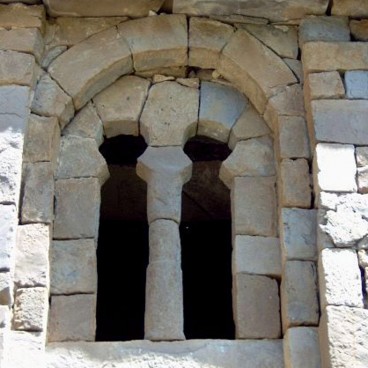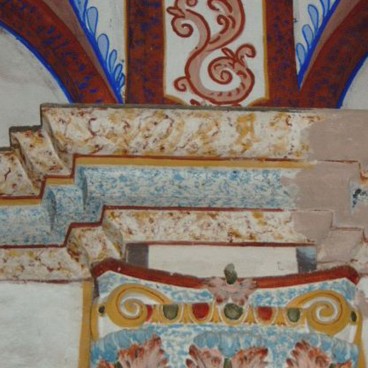Saint Eulalia’s, Susín – Santa Eulalia de Susín

LOCATION
- Locality: Susín
- Where: Urban centre
- How to get there: From the A-136 take the turn-off for Oliván, go through Olivan and continue on the path.
- Signposting: There is a signpost at the turn-off on the road and on the approach to the village.
- Spatial orientation: Village centre
The hamlet of Susín, which has two houses and the Church of Saint Eulalia, is located in a flat area surrounded by woods on the slopes overlooking Oliván. One of the Serrablo Churches (10th/11th Century, it is famous for its small horseshoe-arched window.
Of the original church only the apse and a few metres of the sidewalls remain. At the southern end of the Church the mullioned window with two horseshoe arches have been preserved. The apse is decorated with a frieze of columns and five wall arches, with a central window.
Six carved stones, not seen in the other Serrablo Churches, are also unusual; in general, the Churches do not have this type of decoration. The stone blocks are decorated with geometric designs (angles and spirals), as well as with a cross and the letters alpha and omega.
The Church was extended in the 18th Century and a barrel vault nave with lunettes was added decorated with paintings, and a solid tower was built over the original apse (which was converted into the sacristy). The tower has four sections separated by imposts.
In 1966 two fragments of wall paintings were found in the original apse. They have been dated to the first half of the 12th Century and currently are held at the Jaca’s Diocesan Museum (Museo Diocesano de Jaca). One of the fragments is known as “The Weepers” or “The Weepers of Susín”. The style of painting is similar to that of the painter from Tahull (Lérida) known as Maestro del Juicio Final (Master of the Final Judgement), although not of the same quality.
The Church has been declared a Property of Cultural Interest (and a Historic/Artistic Monument since 1982).

